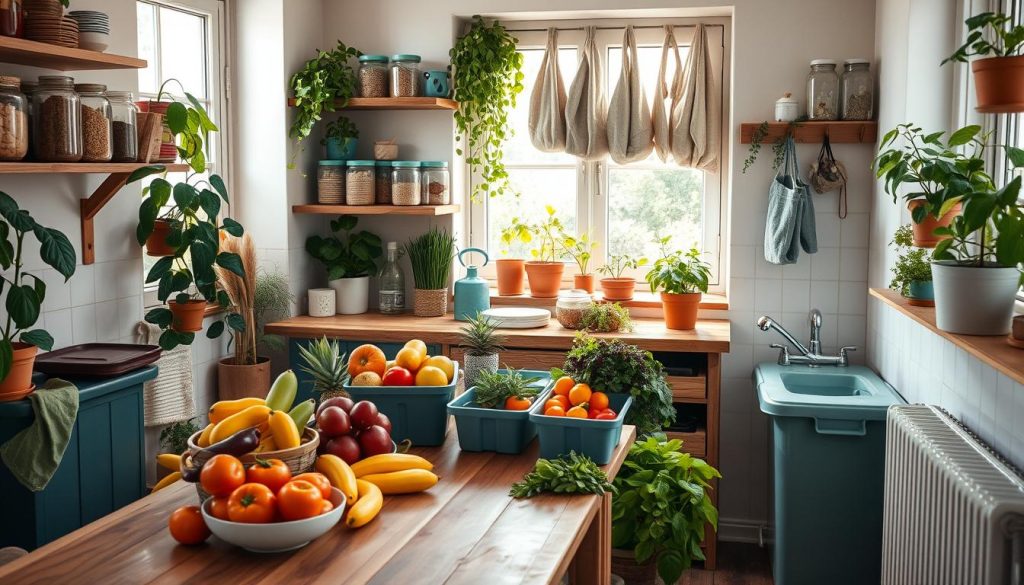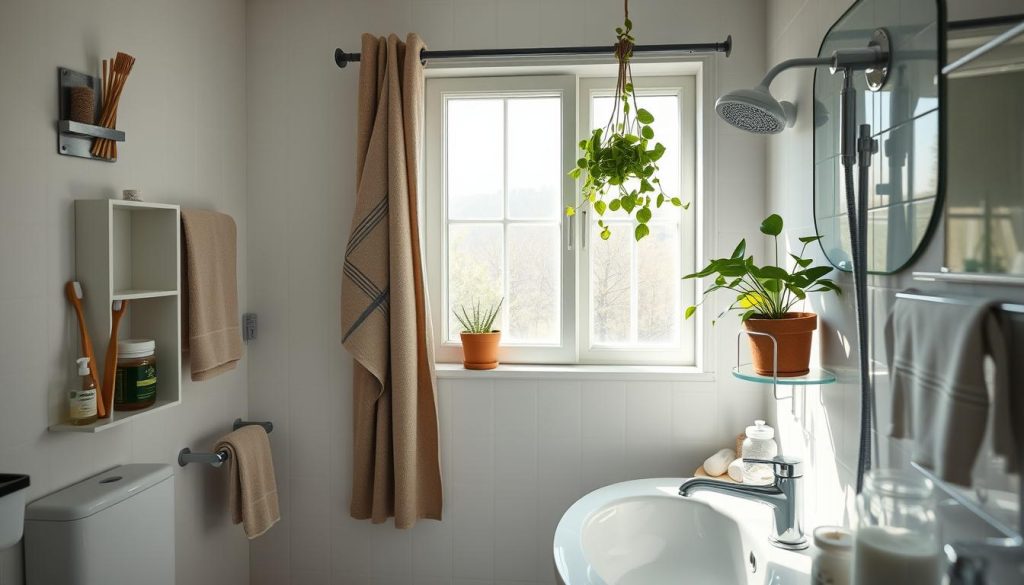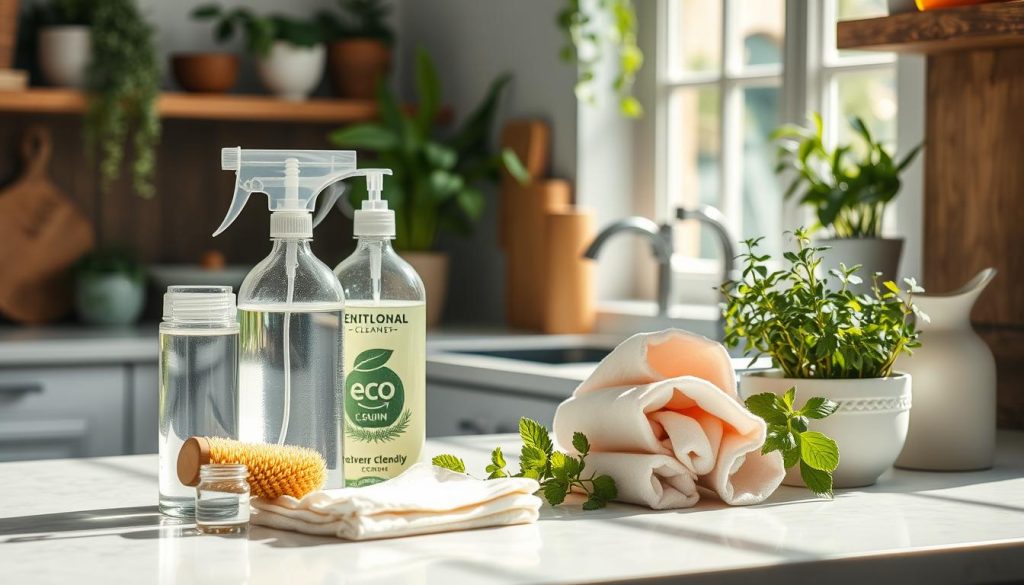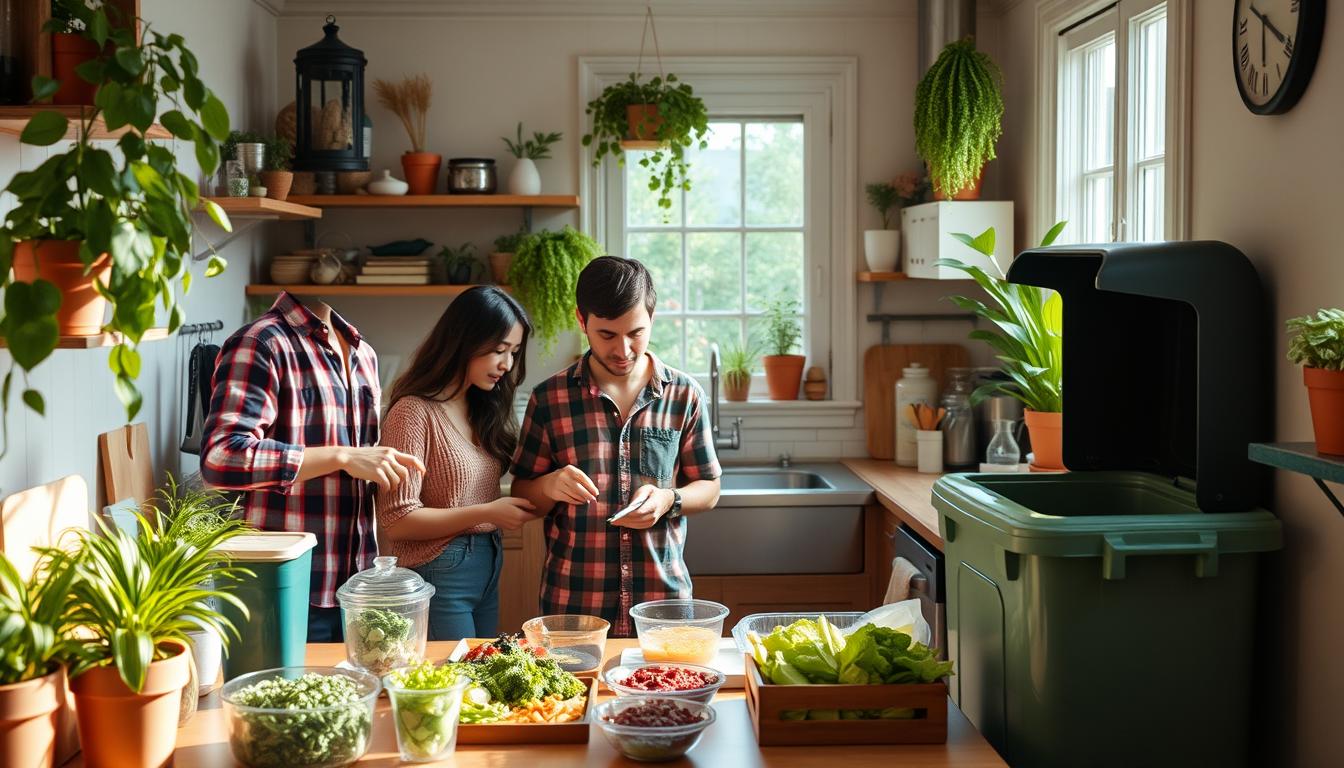I’m excited to share some family-friendly zero waste habits that can transform your home into an eco-friendly haven. As a parent, I know how challenging it can be to balance daily responsibilities with sustainable living. But trust me, it’s not as daunting as it seems!
In this guide, I’ll walk you through practical tips to reduce household waste and embrace a more sustainable lifestyle. We’ll explore easy ways to involve the whole family in eco-friendly practices. Let’s dive into the world of zero waste living and discover how small changes can make a big difference for our planet.
Understanding the Zero Waste Lifestyle for Families
As a parent, I’ve found that zero waste living is more than a trend. It’s a choice that can change how our family affects the environment. Let’s see how it impacts us and our kids.
What is zero waste living?
Zero waste living means making almost no waste. It’s about changing how we buy and use things. For families, this could mean using reusable diapers, packing lunches without waste, or choosing secondhand toys.
Benefits of adopting zero waste habits
Choosing zero waste living has many benefits:
- It helps protect the environment by reducing landfill waste and saving resources.
- It can save money in the long run by buying in bulk and using reusable items.
- It improves health by using natural products instead of harmful chemicals.
- It teaches kids about sustainability and responsibility.
Overcoming challenges as a family
Switching to zero waste living can be tough, but it’s doable with teamwork. Begin with small steps, like changing your kitchen habits. Involve your kids and make it fun. Remember, every small step helps make the planet cleaner for our kids’ future.
Getting Started: Assessing Your Current Waste Output
Understanding what we throw away is the first step to reducing waste. By doing a simple waste audit at home, we can find ways to improve. This helps us set achievable goals for using resources wisely.
I collect all trash and recycling from our home. Then, I sort it into categories like food waste, packaging, paper, and plastics. This makes it clear where we can make a big difference.
Getting kids involved makes it fun and educational. We turn it into a game, guessing which category has the most items. It teaches them about different materials and encourages them to think about waste.
After sorting, I weigh each category and record the results. This gives us a baseline to track our progress. We use a simple spreadsheet to monitor our waste over time. It keeps us motivated as we see our efforts pay off.
- Food scraps: Start a compost bin
- Packaging: Switch to bulk buying or zero-waste stores
- Paper: Go digital or use reusable alternatives
- Plastics: Opt for reusable containers and bags
Regularly checking our waste makes us more mindful of what we buy. We’ve found ways to reuse items, reducing our environmental impact and saving money.
Family-Friendly Zero Waste Habits for Your Kitchen

The kitchen is the heart of most homes, but it’s often a major source of waste. Let’s explore some simple ways to make your kitchen more eco-friendly and reduce waste as a family.
Meal planning to reduce food waste
Planning meals in advance is a game-changer for reducing food waste. I create a weekly menu and shop accordingly. This practice helps me buy only what we need, saving money and preventing excess food from spoiling.
Bulk buying and plastic-free grocery shopping
Buying in bulk is a great way to cut down on packaging waste. I bring reusable containers to the store for items like grains, nuts, and dried fruits. For fresh produce, I use mesh bags instead of plastic. These plastic-free alternatives help minimize our environmental impact.
Composting 101 for families
Composting is an excellent way to recycle food scraps and reduce waste. We started with a small countertop bin for collecting veggie peels and coffee grounds. Our backyard compost pile turns these scraps into nutrient-rich soil for our garden. It’s a fun family activity that teaches kids about the natural cycle of decomposition.
- Collect fruit and vegetable scraps
- Add dry materials like leaves or shredded paper
- Turn the pile regularly
- Use the finished compost in your garden
By adopting these habits, we’ve significantly reduced our kitchen waste. It’s rewarding to see how small changes can make a big difference in our environmental footprint.
Sustainable Bathroom Practices for the Whole Family

Turning our bathroom into an eco-friendly space is simpler than you think. We can cut down waste and save resources by making a few changes. Let’s look at some easy tips and alternatives for a greener bathroom.
Switching to bamboo toothbrushes was a big help. They’re biodegradable and keep our teeth clean without plastic waste. For toothpaste, we use tablets in glass jars, avoiding plastic tubes.
Shampoo and conditioner bars have changed our routine. They’re small, last longer, and are great for travel. I let my kids pick their favorite scents, making it fun.
Conserving water is key in our bathroom. We use low-flow showerheads and faucet aerators. This cuts down water use without losing comfort. I teach my kids to turn off the tap while brushing teeth.
| Conventional Item | Eco-Friendly Alternative | Benefits |
|---|---|---|
| Plastic toothbrush | Bamboo toothbrush | Biodegradable, reduces plastic waste |
| Liquid soap in plastic bottles | Bar soap with natural ingredients | Less packaging, longer-lasting |
| Disposable razors | Safety razor with replaceable blades | Durable, less plastic waste |
| Cotton swabs with plastic stems | Bamboo cotton swabs | Biodegradable, eco-friendly materials |
By using these eco-friendly tips and alternatives, we’ve cut down bathroom waste a lot. It’s a small step towards a greener lifestyle that helps our family and the planet.
Eco-Friendly Laundry and Cleaning Solutions

I’ve found some great eco-friendly tips for laundry and cleaning. These changes have made my home routine better. They cut down on waste, save money, and keep us healthy. Let’s look at some easy ways to make a big difference.
DIY Cleaning Products
Creating my own cleaning products has changed everything. I blend vinegar, baking soda, and lemon juice for effective, safe cleaners. These natural ingredients clean surfaces well and keep my home clean without harmful chemicals.
Microfiber-Catching Laundry Bags
To fight microplastic pollution, I use special laundry bags. They catch tiny fibers from synthetic clothes. This stops them from getting into our waterways. It’s a simple way to help the environment while doing laundry.
Energy-Efficient Washing and Drying Techniques
I’ve learned to save energy with my laundry. Washing in cold water and air-drying clothes are two big helps. For dryer use, I employ dryer balls to cut down on energy.
| Eco-Friendly Laundry Tips | Benefits |
|---|---|
| Use cold water | Saves energy, gentler on clothes |
| Air-dry clothes | Zero energy use, extends fabric life |
| Reuse items like old towels | Reduces waste, saves money |
| Use natural detergents | Better for skin, eco-friendly |
By using these eco-friendly tips, I’ve cut my household’s environmental impact a lot. It’s incredible how small changes can have a big positive effect on our planet.
Creating a Zero Waste Playroom and Toy Collection
Creating a zero waste playroom is a fun project for the whole family. It’s about choosing toys that are good for the planet and spark creativity. This way, we can make a difference and have fun doing it.
One smart move is to use a toy rotation system. We sort toys into groups and switch them out often. This makes playtime exciting and keeps the room tidy. Plus, toys stay interesting longer when they’re not always out.
When picking new toys, I look for eco-friendly materials like wood, organic cotton, and recycled plastics. These toys are not only better for the environment but also more fun. Kids often prefer the natural feel and colors of these toys.
Turning everyday items into playthings is another great idea. Cardboard boxes become castles, and old sheets become superhero capes. My kids love making their own toys, which boosts their creativity and problem-solving skills.
Keeping the playroom organized is key. We use fabric bins and wooden shelves to keep toys in order. Getting the kids involved in organizing teaches them about taking care of their things and being mindful of what they consume.
By following these zero waste tips, we’ve made a playroom that’s both fun and educational. It teaches us all about taking care of our planet.
Sustainable Fashion Choices for Growing Kids
As a parent, I know how fast kids grow out of their clothes. That’s why I’ve started using sustainable living for their clothes. Let’s look at some eco-friendly fashion options for growing kids.
Second-hand Shopping Tips
I enjoy finding second-hand treasures at thrift stores and consignment shops. It’s a smart way to reuse items and save money. When shopping second-hand, I check for quality and look for any wear signs. I’ve found great deals on designer kids’ clothes this way!
Clothing Swaps and Hand-me-downs
Organizing clothing swaps with other parents has changed our family’s life. We meet up seasonally to exchange clothes, toys, and books. It’s a fun way to promote sustainable living and save money. Hand-me-downs from older siblings or cousins also help clothes last longer.
Repairing and Upcycling Clothes
Learning basic mending skills has helped us fix our kids’ favorite clothes. I patch jeans, sew on buttons, and fix small tears. For clothes that can’t be fixed, we upcycle them. Old t-shirts become cleaning rags, and worn-out jeans make fun bags or aprons.
| Sustainable Fashion Method | Benefits | Tips |
|---|---|---|
| Second-hand Shopping | Cost-effective, reduces waste | Check for quality, wash before use |
| Clothing Swaps | Free, builds community | Organize seasonally, invite various sizes |
| Upcycling | Creative, extends clothing life | Learn basic sewing, involve kids in projects |
By choosing sustainable fashion, we teach our kids about saving resources and being creative. It keeps their wardrobes fresh and fun.
Zero Waste School Lunches and Snacks
Packing school lunches and snacks can lead to a lot of waste. I’ve found some eco-friendly tips to help. These tips make lunchtime better for our kids and the planet.
Reusable containers are essential for less waste. I use stainless steel bento boxes, cloth snack bags, and silicone pouches. They keep food fresh and avoid disposable packaging.
Preparing snacks in bulk is another smart move. I buy big amounts and put them in reusable containers. This reduces packaging waste and saves money.
It’s great to involve kids in packing their lunches. We make it fun with a “lunch packing station” and reusable items. This teaches them about eco-friendly choices.
| Waste-Free Lunch Item | Eco-Friendly Alternative |
|---|---|
| Plastic sandwich bags | Reusable silicone bags |
| Disposable water bottles | Stainless steel water bottle |
| Individually wrapped snacks | Homemade snacks in reusable containers |
| Plastic utensils | Bamboo or metal utensil set |
| Paper napkins | Cloth napkins |
These zero waste strategies help us reduce our environmental impact. They teach our kids about sustainability. Small changes in our daily lives can lead to a greener future.
Family-Friendly Zero Waste Habits for Special Occasions
Special occasions don’t have to mean extra waste. I’ve found that family-friendly zero waste habits can make celebrations even more meaningful. Let’s explore how to keep the fun while reducing our environmental impact.
Eco-friendly birthday parties
Birthday parties can be a blast without single-use decorations. I love using reusable banners and cloth tablecloths. For activities, we set up craft stations where kids make their own party favors. This adds a personal touch and cuts down on plastic trinkets.
Sustainable holiday celebrations
Holidays are perfect for creating new, eco-friendly traditions. We decorate with natural items like pinecones and branches. For gifts, we focus on experiences or homemade treats. These family-friendly zero waste habits bring us closer while promoting sustainable living.
Zero waste gift-giving ideas
Gift-giving can be tricky, but I’ve found some great zero waste options. We often give homemade items like baked goods or crafts. For store-bought gifts, we choose durable, plastic-free options. Wrapping gifts in fabric or reusable bags adds a special touch without creating trash.
